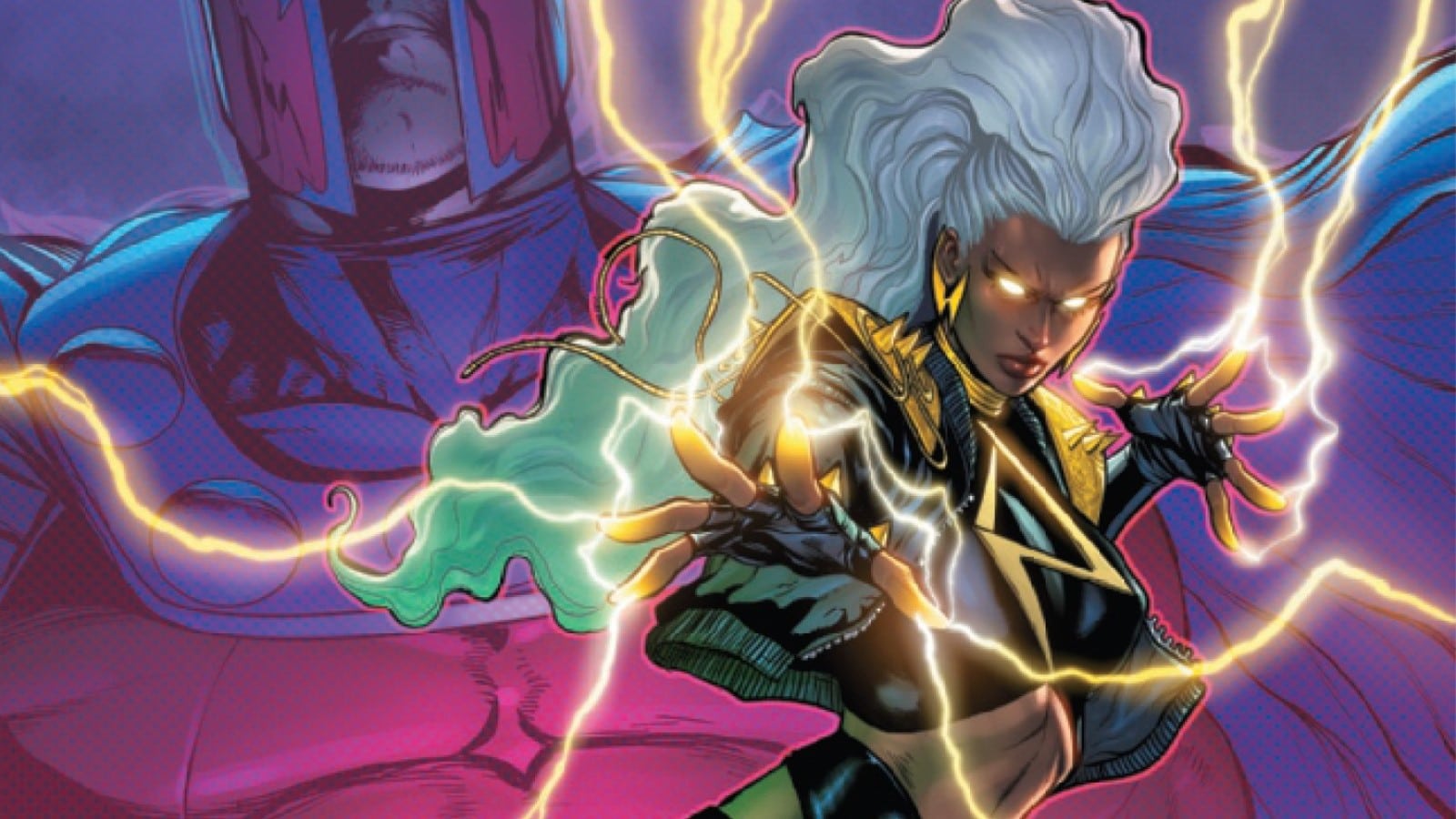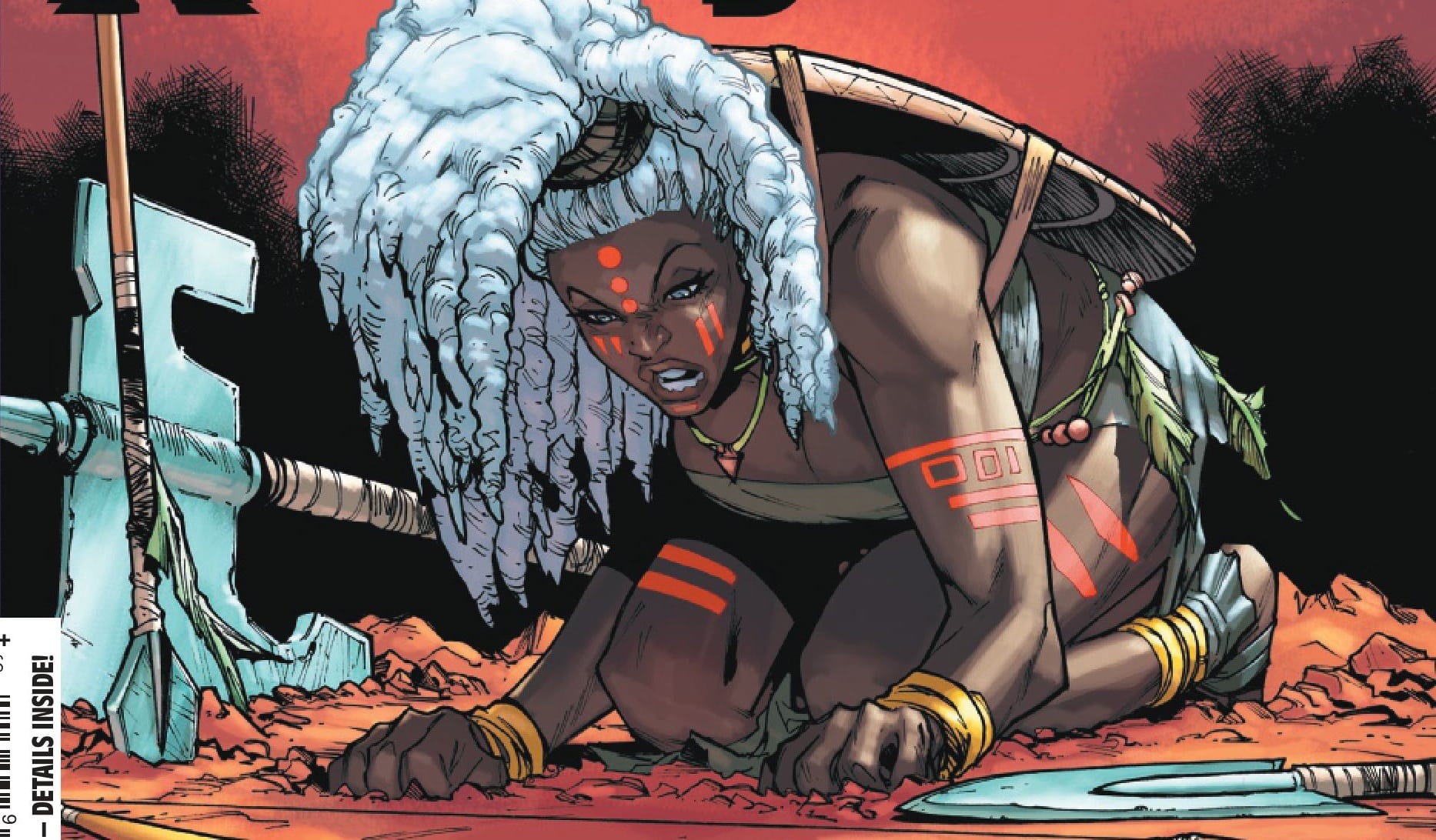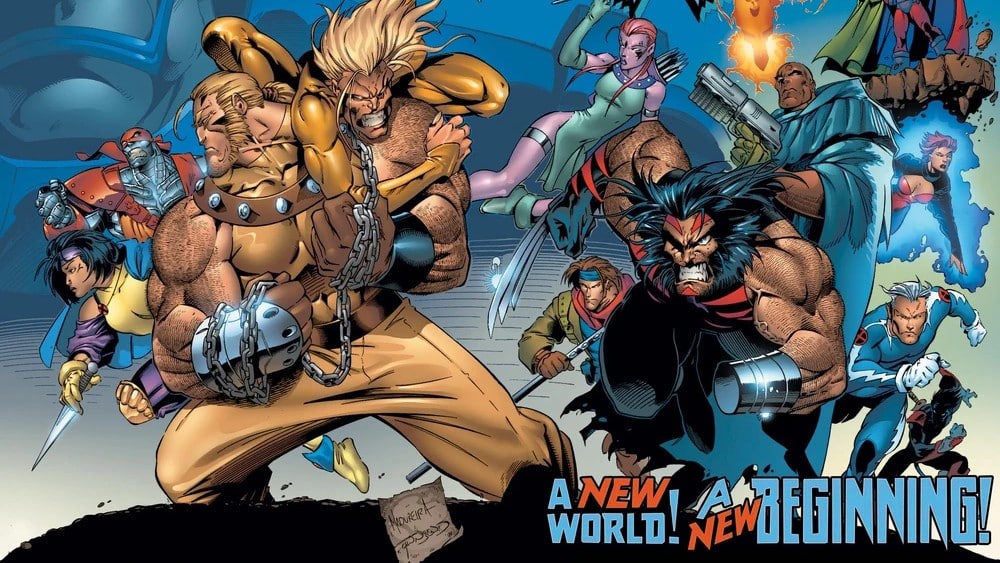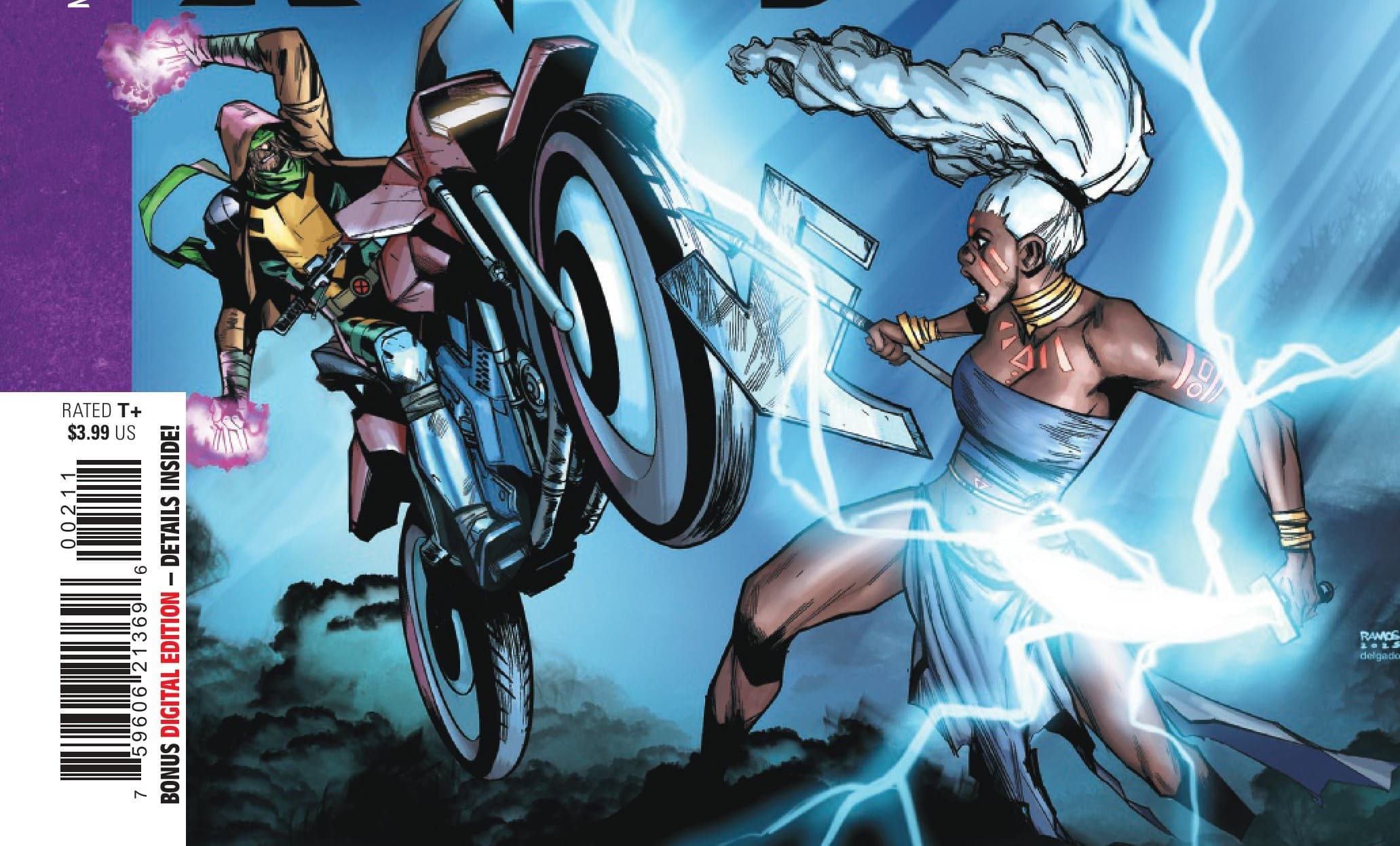On Krakoa, resurrection from the dead was as easy as completing a circuit. But Krakoa fell. The time of easy miracles is over, and only the hard roads are left. Now, it falls to Storm to bring the X-Men’s oldest enemy home. But after all he did, and all that was done to him, can Magneto bear to return? Resurrection of Magneto #1 is written by Al Ewing, drawn by Luciano Vecchio, colored by David Curiel and lettered by Joe Sabino.
Jude: There’s no need to bury the lede here: The Resurrection of Magneto #1 is perfect.
Full stop.
Rarely has any X book — nay, any piece of art — captivated me the way Al Ewing’s magnum opus of mutantdom has.
This is what good writing looks like: There is no wasted space here. Every line of dialogue, every beautifully illustrated and conceived panel, every allusion and insinuation fits perfectly. Like a jigsaw puzzle that’s only one piece from completion, Ewing gently places down the final pieces of his narrative puzzle, revealing an amazing, intricate, satisfying, earned whole.
This is what good science fiction and fantasy look like: insane conceits (magical demigods, trans-dimensional travel, sentient machine planets and an unyielding array of afterlives) humanized and made tangible, using that insanity as allegory to view ourselves through a warped, intriguing funhouse mirror.
Tony: Legitimately, I have to agree. The last time I had a debut issue of a story that captivated me like this was the debut issue of Ewing and Valerio Schiti’s S.W.O.R.D. I don’t love giving comics a letter or number grade (for reasons not worth getting into here), but I would absolutely say this is the first single issue I’ve read since S.W.O.R.D. #1 that I would give a perfect 10.
I stepped away from it actually feeling inadequately prepared to talk about it because there is so much here. It’s on a level that you do not see mainstream comics — hell, most non-mainstream comics — exist on.
Jude: This is what amazing character work looks like: Subverting the reader’s expectations by creating one of the best Storm stories of the past 10 years: a story where she has full agency, where she is both vulnerable and powerful, thoughtful and petty, kind and unyielding.
Alive and, maybe, finally, not.
This is what excellent pacing looks like. And a colorist who understands skin tone and scene setting, and
And
And
And yeah.
This was good.
This is so good, as a matter of fact, that it makes me angry.
Angry that after starting the Krakoan era with so much promise, so few recent X-books (save Immortal X-Men and Sabretooth) have lived up to this standard.
Angry that, as the era slogs to a reset, years of character progress (progress that, not so incidentally, has overlaid with societal progress of representation) will be undone in the service of corporate synergy and acquiescence to the worst kind of people.
Angry that something I love may die.
And yet, as the Arakkii say, “I am not afraid of a life that ends.”
And what are endings but opportunities for beginnings unseen?
So then, let us use this eulogy to memorialize the beauty we bury, in hopes that bountiful brilliance will eventually blossom.
Tony: Jude, that was so incredibly poetic, I don’t want to interject at all. But yes, you absolutely nailed it.
Want to know how this makes me angry?
That we didn’t get this sooner. Ewing is easily the best Storm writer AND the best Magneto writer we’ve gotten since at least Chris Claremont. Yet he wrote relatively little of both in the Krakoan era, and it’s now (probably) coming to an end. But what a way to go out.
I Just Am

Jude: I assume the opening pages signify Magneto actively reaching out to Ororo from beyond the grave. And yet, think about where Ororo is mentally: Her people, forever outcasts, have once again been slaughtered; she’s saved the planet she had a hand in creating and protecting, akin to saving her own child she’s seen suffer, almost annihilating itself in civil war; she’s lost the respect of a mentor (Xavier); she’s lost the comfort of her ex-husband (Panther); she’s lost a sister to the void (Jean); and yes, she lost her once enemy, then accomplice, Magneto.
So yes, these night screams may very well be a magical incantation come to life; but they could also be PTSD: a manifestation of survivor’s guilt, a wish to bring back — or trade places with — the souls they’ve lost.
Tony: Yes, absolutely. And you have to look at the symbolism in that page as well. Our good friend Robert Secundus did some research for us and found that opening Magneto page is a direct pull from the tarot, specifically the Five of Cups. And what does the Five of Cups symbolize?
From Rachel Pollack’s writings on the tarot: “Loss, sadness, regret. Recognition of something not appreciated until it has ended. Someone wrapped in grief, not seeing what remains.” Which opens up so much in that page. Is Magneto who that’s directed at? Or is it directed at Ororo? Or, as we’ll see later in the issue, likely both.
In X-Men Red, Magneto and Storm were allies, but I wouldn’t think of their relationship as having any intimacy until “Judgment Day” hit. There was a connection there in those issues that has resounded through the rest of the series, leaving something missing the entirety of the run afterward. Without a doubt, this story was the only way Ewing’s Space X-Men epic could have ended.
Jude: Craig Marshall, her current consort, serves the same role she served to T’Challa in several (too many!) Black Panther storylines: a plot device. From using his kindness toward children to frame her angry nature; from using their date to frame her desire to live a normal life. Sure, it’s interesting to see baseline humans who don’t hate mutants interact with mutants — I’m not sure if I could date someone who could spontaneously combust me during an argument! But still, his main role is to represent the stability Ororo wants but must ultimately, repeatedly sacrifice.
She, once again, must own the burden of being her, and do what is necessary for someone else. Yes, in his arms she doesn’t have to be a queen or a warrior, yet she is a queen and a warrior, and she cannot run from what she is.
Tony: Exactly, and once again, I wish we got more time with this relationship.
Impossible Is Where I Like to Start

Jude: Ewing’s Defenders run is a wild, wieldy, mystical, fanciful ride through timelines and dimensions, with a motley crue of characters of varying power and equal intrigue.
You should read it.
Tony: I have meant to for so long. I finally need to sit down and do it.
Jude: That said, what you need to know from that run is laid plain: Blue Marvel, the anti-matter-endowed civil-rights era super scientist, constructed portals to different dimensions — even those outside this universe (ergo why he’s spending time with Galactus’ mother. … Again, read The Defenders).
Thanks to an Apocalypse-magic endowed, Redroot-spawned plant, Ororo has a key to the Waiting Room, the resting place of all mutant souls, created by the Witch Wanda to atone for her sins.
Yes, this is a lot. As Storm notes, describing all this to someone who “wasn’t there” (There’s that Arakki term — she’s really become one of them) would leave them bewildered. And for plot connection reasons, the explanations are welcome … but they are not necessary to appreciating the book.
How Dilithium crystals work in Star Trek is irrelevant; Captain Kirk’s decisions matter.
It doesn’t matter why Superman can fly; what matters is whom he flies to.
Amazing science fiction is not defined by its hard science, so much as its effusive humanity.
And there is a lot of humanity in this book.
Tony: This scene works not because of the technobabble or Ewing tying his massive Marvel Universe epic together. It works for two reasons: 1) what you just said, its humanity, but 2) it shows the thought put into it. It could have been hand-wavey and dismissive. It could have been simplistic, such as Storm going to Doctor Strange.
Instead, Ewing knows there’s more than just more interesting ways to do it, he’s able to go big and cosmic. This is one of his best skills as a writer. And while here he does it with his story beats, he’s not above using the toys that others have given him, such as Dario Agger in Immortal Hulk and Immortal Thor.
I really love this scene with Brashear for exactly that reason.
Welcome to the Afterlife

Jude: Imagine dying and waking up to the face of the devil.
Imagine the first person you see is someone for whom you have nothing but contempt.
Imagine seeing Tarn.
Tony: This might have been the most straightforward part of the issue, and even then, there’s so much to it. Someone just looking for superhero punching could see this as exactly that. However, on a deeper read, this is a philosophical battle for Ororo as much as it’s physical. And Tarn representing the evil beyond death, not Mephisto or any number of Marvel demons, makes this have a deeper personal impact for Storm.
Jude: He’s maybe a more sadistic version of Sinister, wielding the power to rewrite people’s genetic code to fit his selfish, sadist whims. Here, literally playing the role of the devil (seducing, tempting, lying by disorientation and omission), he challenges Storm immediately, electing to get some kind of revenge on her and, by proxy, the man who killed him.
And what does revenge look like to him? Taking her autonomy, integrating it into his self, and using her for his pleasure and purposes.
At a meta level, is this not what we fear for characters that we love — that they’ll be stripped of everything interesting to fit the needs of an evil whole?
Is that not what we fear as Krakoa dies?
Have we not feared that for Storm, a Black woman often used as a plot device for men?
Is that not, to a degree, what she’s being asked to do in this story?
Ergo her effusive retort is as poignant as it is purposeful.
She quickly surmises that, in this plane, Tarn is limited to only controlling himself, as she can “only” control herself … and there are few people in the Marvel Universe with as much mastery of self as Storm. She makes quick, beautifully illustrated work of Tarn, heeding his (mis)information and disregarding his threats. We’ll see him around; he told us death and life are fluid, that people move continually between dimensions (“how could it be paradise if people couldn’t leave?”) and he’s simply waiting for his opportunity to return.
Spoken like a true comic book villain.
Tony: Indeed. I truly hope he’s back later in the series. What a fantastic choice for an antagonist.
Walk with Me

Jude: Maybe you’re sacrificing a goat; maybe you’re giving a devil a piece of your soul. But there is no magic without paying a cost first. When Ororo’s ancestor Ashake (a Chris Claremont creation, first seen in New Mutants in the mid-1980s), descended from the clouds to provide counsel and guidance, I wondered, “Where was she a few minutes ago? Could she not have helped make shorter work of Tarn?”
But Ashake is magic, and the cost of her magic — of her guidance and support — was Ororo’s decisive actions, both in power and in restraint. She earned the support of her ancestor, and that ancestor is certainly here to listen — even, apparently, to Storm’s inner thoughts. This makes sense, as Storm comes from her: in a space beyond mortal boundaries, why wouldn’t their connection be more fluid?
And again, I wondered why Storm needed to tell someone who knew her inner thoughts why she was there. And again, the answer is magic: She must recite the incantation — the reason — aloud. GIving her reasons for being here — to save a man whom she can’t fully call a friend for the benefit of those who would still call him an enemy.
Thus, Storm yet again ventures toward the unknown, armed only with her knowledge of self, her reserve and a vision that her earthly body is suffering while her ethereal being wanders.
The balance of more than one life depends on her actions, and thus she chooses to step into the unknown, a place where “symbols and metaphors are true reality” into the spire (oh, look at that, a mutant spire finally being used for something impactful!), and into the abyss.
Tony: And this space is FULL of symbols. The Living Tribunal representing judgment. An array of colored orbs that could represent the Infinity Gems, or could represent the Star card from the tarot while using Marvel symbols, just like the Five of Cups, or both. The Wheel of Fortune.
Now we do know that the Tower represents something in the tarot as well — “upheaval, release, REVELATION.” Which is exactly what Storm gets (and apparently Magneto did before her). While the Waiting Room gave us a confrontation and some information, the Tower is where Ororo is given the information she needs to complete her quest.
You Are Linear. We Are Not.

Jude: As Ororo fights for her agency, we must duly acknowledge her journey may rob Magneto of his. As she falls from the tower, she feels a solidarity with Magneto, connecting her freefall with his spiritual and emotional fallings and failings. This empathy walks a tightrope: It focuses her path with his, yet does not make her journey narratively subservient to his. She is still autonomous, still making decisions, making associations, choosing and, poignantly, questioning her choices in a way few mutant leaders ever did.
And this willingness to question — to seek answers — attracts the entity that seeks to have all the answers.
A Dominion.
Not the Dominion, but a Dominion.
Tony: Specifically a Phalanx dominion. Once again delivering on the promise of HoXPoX that much of the rest of the era didn’t fulfill.
Jude: There was always more than one — more than one timeline, more than one set of intelligences seeking transcendence.
Thus, Storm, out of space and time, falls toward the being that’s threatened and taunted all of existence.
Important to note: the Phalanx continually notes it is not linear: In Defenders, the Omega council of Beyonders (the five figures with Omega symbols on their chests we see from below — wearing the same clothes they wore in Defenders — notes that they are linear, constrained by the need to take one step before another. Just as the Defenders stories were told from varying angles and times, thus might we expect some time and scene jumping in this series.
(Also: note Loki was a member of the Defenders, and we know the God of Stories loves to stick their hands in places they probably shouldn’t. A “trickster” Dominion sent Omega Sentinel back in time. Just saying.)
Tony: …
Dammit Jude. I didn’t even think of that. And Ewing has been Loki’s main writer for years now. You’ve probably got something there.
Jude: These omega men (s/n. Remember the omega people?) tried and failed to contain Enigma, likely because they’re constrained by linear action.
And yet here is Storm, facing an intellect many magnitudes her superior, still holding her own.
She gains knowledge from they who seek to gain it for themselves. Perhaps because of her curiosity and, perhaps, because of Magneto’s lack of curiosity or desire to entertain conversation, they dispensed with him, and seem intrigued with her.
Tony: And again tarot symbolism. On the page we see them “dispose” of him, he’s in the pose of the Hanged Man — “Attachment to deep values. Seeing things differently than those around you. Joy, even revelation. Alternatively, being stuck, or a sacrifice.”
I mean, if that doesn’t describe Magneto in general, and his specific circumstances in particular, I don’t know what does.
Jude: And how does one fight off an insurmountably powerful intelligence with infinite time and ability to attack?
Well, you punch them in the face.
Obviously.
This is a comic book, after all.
Thus, Storm finally finds her footing, landing in the same space she saw Magneto in her dreams, ready to rescue (or conscript?) a tired soul for yet another unending fight.
Tony: And she’s mirroring his image nearly exactly. It’s again the Five of Cups.
Jude: We end the work seeing Magneto, in yet another Tarot card conjecture, blind, over a river of lava, surrounded by names we assume represent those lost to him, either by his hands or someone else’s.
Tony: This was remarkably interesting to me. Are the names those he lost? Are they his victims? Are they the mutant lives he could have saved had he not sacrificed himself?
And he’s not just blind. It appears that his blinding was recent and violent.
Jude: Magneto is in a prison of his own creation, and it is likely that Storm, for all her strength, may not be enough to pull him out.
“If i didn’t define myself for myself, I would be crunched into other people’s fantasies for me and eaten alive.” — Audre Lorde
Responsibilities can feel like prisons, requiring sacrifice of pleasure. Yet responsibility can yield freedom — for one’s self and others — to purse paths of freedom.
This story is brilliant because it centers Storm in autonomous, powerful and vulnerable ways. Storm is responsible; her view of responsibility determines her choices, and she actively, purposefully will let go of anything — and anyone — who dares limit her choices.
It bears saying again: This is the best Storm-centered story in ages, and maybe the best character work of the entire Krakoan era. This book, this story, this entire creative team is brilliant, and I look forward to how that brilliance will illuminate the plight of Magneto next month.
Please, buy this book.
Magnetic Musings
- Haven’t really dived into the Kabbalah/mysticism influences (that’s worth a whole article on its own!), but this thread does an excellent job of laying things out. Again, you don’t need to know these things to enjoy the story, but reading them makes the journey so much more insightful.
- There’s an argument that the Kenyan woman’s ancestor maybe should have been Kenyan and not Egyptian, but that’s neither here nor there.
- Al Ewing continues his streak of successfully writing and centering Black characters. This series opens with a Black woman being loved and protected by a Black man. Another Black man, renowned for his intelligence, provides the mechanism for her travels. A(nother!) Black woman provides guidance and emotional support. Their voices are regal, inquisitive and caring. And while certainly, yes, I want more stories about Black (and non-Black!) characters to be written and edited by Black creators, I also want white creators to write stories that center Black characters without falling on tired tropes and stereotypes.
- This is one of the most nontraditional superhero comics you will read this year. Don’t let that scare you away.
- I truly hope the rest of this series doesn’t turn traditional. This was beautiful and thrilling and gorgeous.
- We didn’t talk much in specifics about Vecchio’s art, but this is a level up for him. Absolutely amazing work that doesn’t just meet the challenge of the script but exceeds and elevates it.
Buy Resurrection of Magneto #1 here. (Disclaimer: As an Amazon Associate, ComicsXF may earn from qualifying purchases.)







